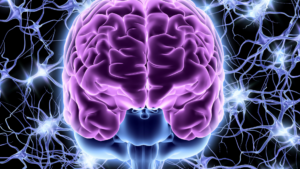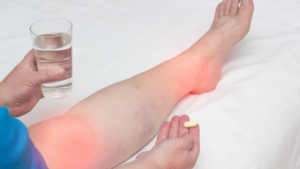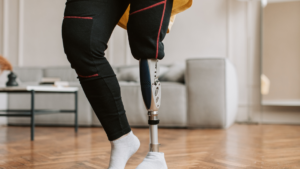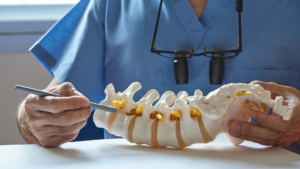Chronic pain is pain that is ongoing or lasts longer than 6 months. And while this pain can be debilitating and affect your daily life, it can also cause other serious health issues and affect the central nervous system.
How Pain Signals Work in Your Body
Your brain and spinal cord work together to receive pain signals from nerves and muscles, which send patterns of signals to the rest of the body. These signals help the body control leg, arm, and spine movements. These signal patterns develop and allow us to ride bikes, walk, or even play an instrument or knit.
However, when you are experiencing chronic pain, the sensors and nerves that send out pain signals “misfire” and the brain and spinal cord are unable to function properly in accordance with what the signal is trying to communicate. The spinal cord reacts in a way that increases a normally harmless pain signal, creating severe chronic pain.

How Chronic Pain Affects the Central Nervous System
The Relationship Between Pain and the Central Nervous System
When the spinal cord increases the pain signals, your central nervous system understands them as incredibly intense and painful. Even harmless signals are miscommunicated as horrible pain signals. The central nervous system operates differently than a pain-free nervous system and causes the patient to become more sensitive with less provocation. This is referred to as “central sensitization.”
Not only are patients who suffer from central sensitization extremely sensitive to things that should hurt, but ordinary things like a simple touch or slight pressure can be excruciating. Pain that typical patients may describe as a two on a numeric pain scale (1-10 level of pain) may feel like an 8 or a 9 for patients that have central sensitization. The pain becomes extremely amplified, even doing activities such as doing the dishes or walking to the mailbox.
Central Sensitization
Central sensitization is a condition that is associated with the maintenance of chronic pain. During flare ups, the nervous system goes into shock and is in a constant state of high reactivity. Being highly reactive lowers the threshold for the cause of pain and the ability to maintain pain after the injury is healed.
Central Pain Syndrome
Central pain syndrome is a neurological condition. It is caused by a dysfunction that affects the central nervous system, such as multiple sclerosis, Parkinson’s disease, or spinal cord injuries. It can take months or even years after an injury or trauma to affect the CNS.
Similar to central sensitization, central pain syndrome is heightened by light touch. However, the most common symptom is the sensation of burning. Pain increases when the temperature drops, and a loss of sensation may occur.
How Central Sensitization Affects Pain
As peripheral pain signals are transmitted to the spinal cord, there are receptors that determine whether or not the spinal cord should respond. Weak muscle signals can be amplified and misinterpreted as pain. The spinal cord becomes highly irritated and misreads the signals from parts of the body, making them stronger than usual. Patients have even experienced intense pain from the weight of a blanket or bed sheet.
This is the central amplification of a peripheral pain signal. The peripheral and central nervous systems work together to help the body determine how the body reacts to a sensation.
Overtime, chronic pain and misread signals can physically change the way the central nervous system responds to pain. The experts at Progressive Pain Management can help control your chronic pain and reduce symptoms caused by central sensitization.
Fill out the form below to talk to our doctors about chronic pain and symptoms you may be experiencing.
In recent years, research has proven that the body has the unique ability to heal itself. The body can regrow tissue and cells and repair damage to ligaments, muscles, and joints. Through the use of Platelet-Rich Plasma treatments, the body is given a chance to accelerate repair and heal quickly. The effectiveness of PRP is constantly improving thanks to scientific advances and improvements in technology.
What is Platelet-Rich Plasma?
Blood contains components like red and white cells and platelets. The liquid portion of the blood is called plasma and is mostly made up of water and proteins. Its primary function is to help blood cells and platelets move throughout the body. Platelets are special blood cells that cause blood clots, but most importantly, contain growth factors that are crucial for healing injuries.
Platelet-Rich Plasma (PRP) is plasma with significantly more platelets than what is normally found in blood. In fact, the concentration of growth factors can be 5 to 10 times richer than usual.

Platelet-Rich Plasma Therapy
What are PRP Injections?
Platelet-Rich Plasma injections are a concentrated solution of the patient’s own platelets. They use the patient’s individualized healing system to recover injured muscles, tendons, and joints.
How Do PRP Injections Work?
Blood must first be drawn from the patient to prepare for PRP Injections. The blood is then filtered to concentrate the platelets, using a machine called a centrifuge. This platelet-rich plasma is then injected directly to the affected area or diseased tissue. Growth factors are released and increase the number of reparative cells the body produces.
Ultrasound imaging can sometimes be used to guide the injection.
There are two ways PRP Injections can be used:
- Platelet-rich plasma can be injected directly into the injured area. A mixture of PRP and a local anesthetic can be injected into inflamed tissue to help decrease pain, swelling, and accelerate healing. The injection site may be sore for a few days following the procedure and can take several weeks to feel the full effect of the injection.
- Platelet-rich plasma can be used after surgery to aid healing. An athlete with a torn ACL may require surgery to repair the ligament. Healing the ligament can be improved by using PRP during surgery. The PRP is prepared in a very specific way that allows it to be woven into the torn tissues.
Effectiveness of PRP & Conditions They Treat
Studies are constantly being conducted to measure the effectiveness of PRP injections. Results can vary, depending on the area being treated, the overall health of the patient, and the severity of the injury that is being treated.
Some conditions PRP is being used to treat are:
- Chronic Tendon Pain: PRP is very successful in treating tendon injuries such as tennis elbow and Achilles tendonitis.
- Muscle Injuries: Athletes have been using PRP therapies to treat muscle injuries such as a pulled hamstring.
- Surgery: As previously mentioned, PRP is being used in surgery to help heal scar tissue.
- Knee: PRP can be used to help heal the knee after surgeries like an ACL repair or joint replacement. It is also being used to treat osteoporosis in the knee.
There are other uses that are being researched and tested on an ongoing basis to help increase the effectiveness of PRP injections. Fill out the form below to learn more about Platelet-Rich Plasma therapy and how it may help your chronic pain. Someone from the team at Progressive Pain Management will be in touch with you shortly.
Sources:
https://www.ncbi.nlm.nih.gov/pmc/articles/PMC5911760/
https://orthoinfo.aaos.org/en/treatment/platelet-rich-plasma-prp/
https://www.hss.edu/condition-list_prp-injections.asp
Lower extremity pain is commonly due to overuse and inflammation as a result of conditions that affect bones, joints, muscles, tendons, and other organs. The key to pain is understanding what causes it. Only physicians can truly diagnose this kind of pain. There are a few questions to ask when diagnosing pain in your legs, hips, thighs, ankles, and lower joints.
- Is there a recent trauma? Falls to the ground are a common cause for lower extremity pain. This is especially true when a patient is unable to recall periods of time or suffers from a drug withdrawal. There is a chance of fracture, so radiographs should be taken.
- Is the pain articular or non-articular? Articular pain (meaning joint pain) is often accompanied by inflammation or swelling. Non-articular pain is musculoskeletal pain and affects muscles and bones. These differentiating symptoms help physicians diagnose the potential source of the pain.
- What is the root of the pain? When determining and understanding the root of the pain, physicians consider a broad variety of symptoms and characteristics regarding your pain. Things like infection, inflammation, vascular, and neoplastic causes can disguise other sources of pain.

Lower Extremity Pain
Being able to answer those questions helps pain doctors diagnose pain and recommend effective treatments for lower extremities. The term “lower extremities” includes the pelvis and hip joint, thigh, knee, lower leg, ankle, and feet.
Types of Lower Extremity Pain
Ankle
Because your ankle bears the weight of your entire body, it is prone to injury. The ankle is a complex network of bones, tendons, muscles, and ligaments. This means there are a lot of things that can cause pain.
Ankle pain can be caused by a number of conditions, including, but not limited to:
- Achillies tendonitis
- Gout
- Osteoarthritis
- Plantar Fasciitis
- Sprained Ankle
- Stress Fractures
Thigh
Pain in your thigh commonly starts in nerves that surround the hip and radiate down. Muscle pain, nerve pain, and injuries are all factors to consider when looking at thigh pain.
Pain may be caused by:
- Bernhardt-Roth syndrome
- Overuse
- Sciatica
- Peripheral Neuropathy
- Sprained or torn ligament
- Blood clots
Foot
Foot pain can be caused by overuse and conditions that cause inflammation like injury to tendons or ligaments in the foot. Arthritis is a common cause of foot pain. The bottom of the foot has a network of nerves that cause immense burning sensations, numbness, or tingling when damaged.
Common causes of foot pain include:
- Osteoarthritis
- Mortnon’s Neuroma
- Plantar Fasciitis
- Gout
- Diabetic Neuropathy
- Tendonitis
Lower Leg
A wide variety of conditions and injuries can cause leg pain. Generally, the leg pain is a cause of tissue inflammation. This can be a result of injury or chronic diseases. The leg contains many different types of tissues and bone structures, making injury and pain very common.
Leg pain can be caused by:
- Shin Splints
- Stress Fractures
- Diabetic Neuropathy
- Peripheral Artery Disease
- Sciatica
- Deep Vein Thrombosis
Hip and Pelvis
Hip and pelvis pain can be difficult to diagnose. The movement of the hip joint, lower back, and leg bones are all connected by a large network of muscles, ligaments, tendons, and joints. Pain from another area of the body frequently causes pain in the hip and pelvis region. This is called referred pain.
Sources of pain can include:
- Bone Fractures
- Arthritis
- Nerve Damage
- Muscle Injury or Inflammation
Knee Joint
If you use your knees to repetitively kneel or lift heavy objects, you may experience knee pain. Knee pain affects people of all ages. Injuries are common and regularly affect the ligaments, tendons, or fluid-filled sacs surrounding the bone. Cartilage in the knee also gets damaged from normal wear and tear, which can cause pain.
Common causes for pain include:
- Osteoarthritis
- Meniscal Injuries
- Cysts
- Gout
- ACL tears
- Bursitis
Treatment Options
Once a diagnosis has been made, your physician will create a treatment plan specific to your pain. If the cause is musculoskeletal, non-steroidal medications or acetaminophen may be used. If pain persists, stronger medications may be prescribed, although it is rare that narcotics are needed.
If the pain is articular, corticosteroid injections may be used to reduce pain. Muscle and tendon pain can be reduced using physical therapy. However, if the muscle pain is due to arthritis, physical therapy may not be helpful.
Your doctor will work with you to form an effective treatment plan that fits your lifestyle and provides the greatest success in restoring a higher quality of life. Fill out the form below to get in touch with the team at Progressive Pain Management.
Living with chronic pain is often associated with a decreased quality of life, and diminished state of mind and can put a lot of stress on one’s mental health. When your body aches, you know the pain is just not “in your head,” and the discomfort is real. Pain becomes your whole world.
Frequently, patients consider conventional ways of thinking: reducing activities and resting will reduce pain. However, the opposite typically occurs. When you reduce movement and daily activities, your body automatically reduces its capacity to function properly. This change in behavior leads to negative thoughts about pain – “will I ever be pain-free?” or “nothing helps my pain.”
This type of negative thinking affects other aspects of your life, leading to anxiety and depression. That is when therapies like Cognitive Behavioral Therapy are helpful.

Cognitive Behavioral Therapy for Chronic Pain
What is Cognitive Behavioral Therapy?
Cognitive behavioral therapy (CBT) is a form of talk therapy. It has been researched and proven effective across a myriad of diagnosed conditions. It helps people identify and develop skills to change negative thoughts and behavior. CBT is problem-focused and challenges the negative thoughts, beliefs, or concerns contributing to a patient’s mental health regarding their pain. It is more than a stereotypical therapy session that involves talking through a problem and focuses on “doing” things.
The science behind CBT says that individuals – not events or external stimulants – create their own experiences. This includes pain. People can train themselves to incorporate coping skills into their daily lives by changing awareness of pain and thought patterns. For patients with chronic pain, CBT helps patients break their pain cycles and improve their quality of life.
How is it used to Treat Chronic Pain?
Used to treat chronic pain, CBT is commonly used with other modalities of pain management. This may include massage therapy, medications, or physical therapy. CBT has minimal risk and side effects than medication or in extreme cases, surgery, making it an excellent treatment option.
Cognitive behavioral therapy can change a physical response in the brain that worsens pain. Pain causes stress which in turn affects the pain chemicals in the brain. CBT reduces the activity of those chemicals, making the body’s natural pain relief more effective.
The first step of CBT is education. When patients understand their diagnosis and how CBT can help, setting goals and getting in the correct mindset is easier. It also helps the patient identify triggers and behaviors that worsen their pain levels and allows them to learn adaptive behavior. The goal is to increase self-efficacy for managing and reducing chronic pain by correcting negative thoughts and beliefs. Cognitive behavioral therapy treats conditions caused by chronic pain, such as depression, anxiety, sleep disorders, and isolation.
What to Expect from CBT Sessions
CBT sessions vary depending on your provider and pain level, but the initial meeting may be used to normalize the patient’s experience. This involves normalizing their pain – they are not “crazy” or wrong for feeling their pain sensations. The pain is not “all in their head,” and they do not see a “shrink.” These are common concerns and worries of patients who suffer from chronic pain conditions.
There will be a clinical interview where patients are screened through a series of questions, self-reporting, and observations. This allows the doctor to provide feedback about their situation and allows them to educate them about how CBT can be used to help manage pain.
Paper material that use visuals to show the relationship of chronic pain and how it impacts feelings, behavior, thoughts, and their cycle of pain. When patients are able to understand and see these connections, it is easier to relate it to their lives. Visual materials also provide patients with assistance at home, promoting self-efficacy.
Cognitive behavioral therapy aids patients’ development of their own behavior. It “trains” them how to think, act, and feel regarding their pain. The sessions focus on teaching the importance of paced activities that increase function without overexerting yourself and how inactivity can worsen your pain. This trained development allows the patient to create specific, relevant, and achievable goals for themselves. It is often called SMART Goals: Specific, Measurable, Achievable, Relevant, Time-Limited goals.
By slowly incorporating activities into your daily routine, it takes away from the mindset of “My pain limits me” or “I can’t do this.” Once a mindset shift has been activated, any negative mood symptoms begin to dissolve.
CBT is often part of a comprehensive treatment plan, used in conjunction with interventional pain management techniques. The team at Progressive Pain Management works with your other healthcare providers to ensure you get the most out of your treatment plan and the highest quality of care possible.
Fill out the form below to get in touch with our team today!
Phantom limb pain is the sensation of pain that feels like it is coming from a body part that is no longer there. Once believed to be a psychological problem, research shows that phantom limb pain is a real sensation. The sensation originates in the spinal cord and brain.
What is Phantom Limb Pain?
Phantom limb pain is pain in an area with an amputation. The pain can be minor and go away on its own with the symptoms decreasing over time. However, phantom limb pain can be extremely debilitating and can lead to chronic pain. When the pain is consistent and continual for more than 6 months, the chances of your phantom limb pain disappearing on its own is slim-to-none.

The pain is real and not just a psychological phenomenon. During MRI scans, areas of the brain that were previously connected to the nerves in the amputated limb show activity when the patient feel pain.
What Causes Phantom Limb Pain?
The underlying root cause of phantom limb pain is not clear, but it originates in the spinal cord and brain. This is believed to be caused by a mixed signal in the brain. After amputation occurs, spinal cord and brain areas miss input sensations from where the limb should be. The body takes time to adjust. However, this lack of input sensations triggers the body’s most basic message that something is wrong: PAIN.
There are studies that show how, after an amputation, the brain “rewires” that part of the body’s sensory nerves to another part of the body. Because that amputated area is unable to receive sensory information, the information is referred. This means instead of feeling pain in the now-amputated leg, you feel those senses in a still-present hand.
Damaged nerve endings and scar tissue at the amputation site contribute to phantom limb pain. Sometimes the physical memory of the limb can invoke pain, as that sensory information has been retained.
Treatment Options
Treatment options vary depending on the severity of the pain sensations. Like many pain conditions, a combination of multiple treatment options is most effective in reducing pain. It can be difficult to treat phantom limb pain, but your doctor may begin with medication options and noninvasive treatments.
Some medications administered and prescribed to help phantom limb pain are as follows:
- Over-the-Counter Medications: Acetaminophen, Ibuprofen, or Naproxen may relieve phantom limb pain. These should be taken under the direction of your doctor.
- N-Methly-D-Aspartate (NMDA) Receptor Antagonists: This type of anesthetics bind to the NMDA receptors on the brain and blocks activity of glutamate – a protein that plays a crucial role in relaying nerve signals.
- Antidepressants: Tricyclic antidepressants may relieve the pain caused by damaged nerves.
- Anticonvulsants: Typically used to treat epilepsy, this medication is also used to treat nerve pain.
Other medications may include beta-blockers, sodium channel blockers and even low-dose narcotics if the pain is severe. Many physicians do not recommend taking narcotics and find other methods of relieving pain.
Noninvasive therapies do not always work for everyone, and just like medication, the effectiveness is monitored and measured in order to find the most viable solution to treat pain. Treatment options may involve:
- Acupunture: Acupuncture has been found to ease chronic pain symptoms. Long, fine, sterile needles are injected into pain points on the body, relieving tension and pain. It is an incredibly safe treatment option.
- Spinal Cord Stimulation: Tiny electrodes are placed along your spinal cord and an electrical current is delivered to the spinal cord and relieves pain.
- Heat Therapy
- Biofeedback: Training the body to effectively handle and manage pain by learning what the sensations feel like.
- Relaxation Techniques: Meditation, yoga, breathing techniques, and other methods of self-taught relaxation help you learn how to focus your energy away from the pain.
- Physical Therapy: Physical therapists design a treatment plan to incorporate cardio and strengthening exercises into your daily routine that help reduce pain and teach your body how to positively cope with pain.
If those options do not provide effective relief, surgery is available. Talk to your doctor today about starting a treatment plan if you suffer from phantom limb pain. The experts at Progressive Pain Management can help you manage your pain. Fill out the form below to get started.
When you are affected by pain, daily life, normal activities, and hobbies can become a challenge. Even the amount of sleep you get, the thoughts you have, and basic daily tasks can be negatively affected by pain.
Your quality of life and desire to resume regular activities plays an important role in maintaining your health and managing your pain. There are some positive changes you can make to your lifestyle and simple changes to your daily life that make managing your pain easy.

Tips for Living with Chronic Pain
Lifestyle Changes that Make Living With Chronic Pain Easier
Staying Active
Exercise can help those in pain find the relief they are looking for. Cardio exercise utilizes large groups of muscles and raises your heart rate. This combination releases endorphins. Endorphins are your body’s natural opiate (painkiller). Studies show that exercising for 30-45 minutes of low-intensity aerobic exercise is recommended and can help reduce pain.
Be sure to talk to a doctor before beginning any new exercise program.
A Good Night’s Sleep
Pain interferes with sleep – that’s a no brainer. When you are in pain, you are unable to achieve proper REM cycles and relax enough to get uninterrupted sleep. Pain can cause issues when falling asleep or staying asleep throughout the night.
Certain medications can also cause problems with sleep. If your medication causes drowsiness and fatigue, you may be more inclined to sleep during the day which can mess with your sleep at night. Getting the right amount of sleep at night is crucial to how your body copes with pain and how your body harnesses its energy levels.
Here are some ways to sleep better:
- Stick to a Routine: Creating a sleep routine can help you sleep better. Going to bed at the same time and setting an alarm for the same time every day can help train your body to get more meaningful rest.
- Watch What You Eat and Drink: Certain beverages – such as alcohol or caffeine – can affect your sleep patterns. Heavy meals have the same affect. If you have a snack before bed, eating something healthy like almond butter on toast, crackers and cheese, or nuts and fruit are great alternatives.
- Relaxation: Practicing relaxation techniques before bed can help get your mind and body prepared for a restful sleep. Try things like listening to soothing music, practicing deep breathing, and writing in a journal.
Reduce Stress Factors
Stress and pain go hand-in-hand. Your body may react in different ways when there is stress involved, such as tense muscles or headaches. This can be avoided by reducing stressors and managing stress levels.
Stress can cause negative impacts on your work ethic, eating habits, mood, and relationships. By keeping track of what stresses you out and considering how it affects your life. By eliminating or minimizing the stressors in your life, you may find ways to make your days or weeks go smoother.
Taking your life back from the pain caused by chronic diseases can be solved by adjusting your routine and activities. Contact the team at Progressive Pain Management to learn how to manage your chronic pain. Use the form below to get started.
Neuropathic pain is a type of pain where the cause is not found in an organ or tissue and can occur in any part of the body. This type is most common in the limbs but can also occur in joints, stomach, or elsewhere. It occurs when nerve cells are damaged or injured, sending signals to be felt as pain, usually through burning, prickling, and tingling sensations. Neuropathic pain can be complicated to treat because it cannot always be easily located like other types of pain.

Things to Know About Neuropathic Pain
Causes of Neuropathic Pain
Nerve Damage or Injury
Neuropathic Pain can occur when the nerve cells are damaged or injured. This may happen as a result of disease or damage to the nerves. It may also occur when the protective covering surrounding the nerve fibers are damaged.
Degeneration
Neuropathic Pain can be caused by degeneration of specific brain cells or spinal cord cells, which send pain signals to the brain. This type of Pain is often due to dementia, Parkinson’s disease, multiple sclerosis, spinal injury, and diabetes.
Compression of the Spinal Cord
Occurs when a person is experiencing a fracture or vertebral compression in the neck, chest, or back. The most common Pain that can occur with this maintenance is referred to as radiculopathy and is characterized by sharp shooting pains that run down the arms, legs, and back.
How to treat neuropathic Pain
The main goal of treating neuropathic Pain is to manage the pain as much as possible and to reduce the side effects of the treatment. People with neuropathic Pain may be referred to standard medication such as:
Opioids
A class of drugs that relieve Pain by suppressing the central nervous system’s response to pain signals. Examples include hydrocodone (Vicodin) and codeine. Medications like these slow the nerves down, making them less sensitive to pain signals.
Anticonvulsant
These medicines constrict the muscles in the brain by reducing abnormal neuron activity or abnormal neuron growth. Examples include carbamazepine (Tegretol), valproic acid (Depakote) and gabapentin (Neurontin).
NSAIDs(Non-steroidal anti-inflammatory drugs)
These painkillers are most commonly used to treat inflammation and swelling, but they also reduce the effects of nerve damage by suppressing the central nervous system’s response to pain signals.
Acupuncture
Acupuncture is a method that involves placing wonderful needles into acupuncture points and in the back to try to curb pain signals from being sent out. Acupuncture can help reduce a person’s sensitivity to Pain by blocking the nerves and nerve pathways.
Transcutaneous electrical nerve stimulation (TENS)
Treatment involves placing electrodes on the skin and pressing them to send signals to particular nerve pathways. TENS can be used as a treatment for Pain that conventional therapies cannot control.
Rehabilitation
When Pain becomes severe and chronic, severe Pain should be treated first. Treatments after that may include rehabilitation therapies. These include physical therapy, which can help improve mobility and strength, cognitive behavioral therapy, which can help to decrease stress and anxiety related to Pain, and psychotherapy, which can also help reduce stress as well as depression or other emotional problems related to the Pain or different multidisciplinary approaches such as educational programs.
Final Thoughts
Neuropathic Pain is a type of Pain that many people suffer from at one point in their lives. In most cases, Pain can be managed with various treatments and medications.
If you suffer from neuropathic pain that conventional treatments cannot control, Progressive Pain Management is here to help you. Fill out the form below to contact our team for further queries.
Have you or a loved one been experiencing chronic pain for months in your lower body? If so, you may want to consider DRG Therapy, a new treatment method for chronic pain. This blog post explains what DRG Therapy is, who’s a good candidate for it, what you can expect from the treatment, and the next steps you can take.

DRG Therapy for Chronic Pain
What is DRG Therapy?
DRG Therapy stands for Dorsal Root Ganglion Stimulation therapy. According to Penn State Health, a dorsal root ganglion is a collection of sensory neurons at the dorsal root of a spinal nerve. DRGs act like traffic lights, managing the signals and sensations that travel along the spinal column to the brain.
DRG therapy is a type of neurostimulation therapy. This means using invasive and noninvasive techniques and the application of electrical stimulation to drive neural function. Stimulation can ease the pain in specific locations. DRG Therapy is for managing chronic pain in specific areas of the lower body like your:
- foot
- knee
- hip
- pelvis
- groin
While there isn’t a cure for isolated chronic pain, DRG therapy can provide some much-needed relief in those areas. It’s particularly beneficial for those who suffer from chronic pain in the pelvis and lower body.
Are You a Candidate?
You may want to consider DRG therapy if you’re experiencing:
- Chronic pain in a lower part of the body, like your foot, knee, hip, or groin after an injury or surgery.
- Chronic pain that lasts six months or more.
- Minimal or no relief from pain management therapies or traditional neurostimulation, medications, or surgery.
- Only partial relief from other therapies.
What Can You Expect from This Treatment?
The therapy involves a physician implanting a temporary and removable device, i.e., the DRG stimulator. The doctor will work with you to try out the device to see if it can effectively manage your pain before they implant it.
Once implanted, the physician uses a patient “remote control” to send mild electrical pulses from the stimulator to your dorsal root ganglia. The result should be pain relief in the targeted area.
Relieve Chronic Pain and Take Back Your Life
No one should live with continual, daily pain. DRG Therapy is unique because it’s a spinal stimulation concentrating on the lower body area. Relieve the pain so you can live the happy, productive life you deserve.
If you or a loved one has been experiencing chronic pain and are interested in DRG Therapy, Progressive Pain Management is here to help. In addition to DRG Therapy, we offer a wide variety of other pain management treatments and programs. Contact us today, and we’re happy to answer your questions about pain management and help you set up an appointment.
Are you tired of dealing with back pain that just never goes away? The truth is, chronic back pain can be debilitating and difficult to manage. While many different treatments are available to help control your symptoms, radiofrequency lesioning may provide an effective solution.
Radiofrequency lesioning uses high-frequency electrical signals to deliver targeted heat directly to the source of your pain to create a small ablation or “lesion,” which can reduce discomfort for long-term relief. Keep reading to learn more about how radiofrequency lesions work, what they treat, and whether they are right for you.

Using Radiofrequency Lesioning to Treat Back Pain
What is Radiofrequency Lesioning?
Radiofrequency lesioning (RFL) is an invasive procedure to reduce chronic neck or back pain. During a radiofrequency ablation procedure, a doctor uses fluoroscopy (a live x-ray) to guide an electrode needle into the nerve that carries the pain signals from your spine to your brain. The electrode sends radio frequency energy through the needle, creating a small “lesion” that interrupts these painful nerve signals for long-term relief.
Using RFL for Back Pain
Radiofrequency lesioning is commonly used to treat a variety of chronic pain conditions, but it can be especially effective for treating lower back pain. If you have been struggling with chronic back pain, radiofrequency lesioning may be an effective treatment option. The procedure has been shown to reduce the intensity of pain-related symptoms and provide relief from stiffness and movement limitations in the affected areas. Talk to your doctor about whether radiofrequency lesioning is the right choice for you.
Benefits of Radiofrequency Lesioning
- It can provide long-term relief from back pain
- It is minimally invasive and typically requires only local anesthesia
- The procedure is quick – usually lasting around 30 minutes
- It offers the potential for a substantial reduction in the pain you experience
Is the Procedure Safe and How Does it Work?
Radiofrequency lesioning is generally considered a safe and effective treatment option for chronic back pain. Radiofrequency lesioning creates small nerve tissue lesions that interrupt pain signals from the spine to the brain. When these pain signals are blocked, they cannot reach the brain, and you experience long-term relief from your back pain.
The procedure typically requires only local anesthesia and takes about 30 minutes to complete. During radiofrequency lesioning, a doctor uses fluoroscopy (a live x-ray) to guide an electrode needle into the nerve that carries the pain signals from your spine to your brain. The electrode sends radio frequency energy through the needle, creating a small “lesion” that interrupts these painful nerve signals for long-term relief.
Risks of Radiofrequency Lesioning
Although radiofrequency lesioning is considered a safe and effective treatment option, some risks are still involved. These include bruising or bleeding at the injection site and temporary nerve damage that may cause numbness or tingling in the area around the lesion. There is also a small risk of infection associated with any medical procedure.
What can you expect from treatment?
The effects of radiofrequency lesioning vary from person to person. Some people may experience reduced pain immediately after the procedure, while others might take several days or weeks for full relief. Not all cases of chronic back pain can be cured with radiofrequency lesioning, and results may vary depending on the cause of your discomfort.
Get Treatment for Back Pain Today!
If you or someone you know is dealing with chronic back pain, don’t suffer any longer. Radiofrequency Lesioning may be the answer to finding relief. This minimally-invasive procedure uses radio waves to target and heat specific nerve endings, resulting in long-term numbing of the area.
Patients have reported a decrease in both pain and medication usage after having this procedure. Contact Progressive Pain Management to request an appointment!
Epidural steroid injections (ESI) are a minimally invasive procedure performed to help reduce inflammation and pain caused by nerve root compression. Herniated discs, bone spurs, or spinal stenosis cause nerve compressions. Pain, numbness, or weakness along the nerve are symptoms of nerve compression, referred to as radiculopathy. This pain can last for days or even years if left untreated.
An epidural steroid injection aims to help reduce inflammation along the nerve root. Medication is injected in the fat-filled area between the bone and the protective layer of the spinal nerve, called the epidural space. These injections are intended to reduce pain so that normal activity and a physical therapy program can be resumed.

What is an Epidural Steroid Injection
What is an Epidural Steroid Injection?
There are multiple types of steroid injections, most commonly described according to where they are injected. Steroid injections in the neck are called cervical epidural injections. Injections performed in the middle back are thoracic epidural steroid injections, and injections in the lower back are lumbar epidural injections.
The injections can also be labeled according to the direction of the needle. Most epidural steroid injections are placed between the lamina. This is called an interlaminar epidural steroid injection. The needle is aimed upwards toward the head and goes in between two laminae. Another type of injection is a transforaminal steroid injection. The needle travels along the course of a nerve and enters the spine from a diagonal direction. A caudal approach to ESIs allows the needle to enter directly into the epidural space through the sacral hiatus – a small boney opening directly above the tailbone.
The steroid injection contains a corticosteroid, such as triamcinolone, methyl-prednisolone, or dexamethasone, and an anesthetic numbing agent like lidocaine. They are injected into the area between the vertebra and the protective sac surrounding the spinal cord and nerves.
Why Are They Used?
These steroid injections are used in patients who suffer from pain in the neck, arm, lower back, or have sciatica. This treatment has proven beneficial to those with severe inflammatory conditions. Patients who have the following conditions are candidates for epidural steroid injections:
- Spinal Stenosis – a narrowing of the spinal canal and nerve root canal
- Herniated Disc – the material inside a disc can bulge or rupture through a weak area in the cartilage and come in contact with a spinal nerve.
- Degenerative Disc – breakdown or aging of a spinal disc causing the disc space to collapse or growth of bone spurs.
- Sciatica – compression of nerves that causes pain to travel into the buttocks and down the legs.
In some cases, ESI can be used to determine whether surgery will be successful in patients who have a herniated disc. The injections can ease pain enough so a physical therapy routine can be established.
Risks Involved with Epidural Steroid Injections
ESI procedures have been performed for many years and is considered a safe and effective treatment. Although uncommon, some patients do experience side effects from the medication. Patients may experience a “steroid flush” which is a flushing of the face and chest that can be accompanied by a low-grade fever.
Other side effects may include:
- Trouble sleeping
- Temporary water retention
- Anxiety
Serious complications are very rare, but could include an allergic reaction to the contrast dye, infection, nerve damage, or bleeding. When this procedure is performed with fluoroscopic guidance, the risk is minimized. Generally, this type of procedure and injection is very well tolerated by most patients.
To learn more about epidural steroid injections and how they can help back pain, fill out the form below:

